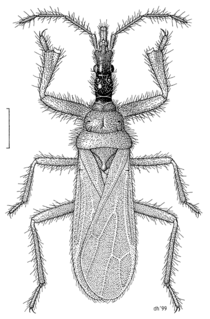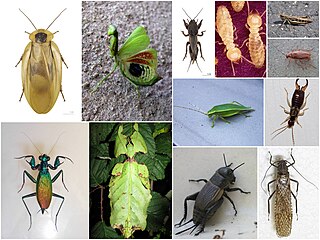
Enicocephalidae, also called unique-headed bugs and gnat bugs, are a family of around 300 species of the suborder heteroptera. They are typically 4 mm long, and found throughout the world. They have an elongated head, constricted in places, hence their head is 'unique'.

Rhopalosomatidae is a family of Hymenoptera containing about 68 extant species in four genera that are found worldwide. Three fossil genera are known.
Michael S. Engel, FLS, FRES is an American paleontologist and entomologist, notable for contributions to insect evolutionary biology and classification. In connection with his studies he has undertaken field expeditions in Central Asia, Asia Minor, the Levant, Arabia, eastern Africa, the high Arctic, and South and North America, and has published more than 760 papers in scientific journals and over 800 new living and fossil species. Some of Engel's research images were included in exhibitions on the aesthetic value of scientific imagery. Engel is the author of Innumerable Insects and co-author of Evolution of the Insects.

Compsocidae is a family of Psocodea belonging to the suborder Troctomorpha. The family comprises two extant species in two genera, both found in Mesoamerica. Compsocus elegans is found in Mexico and Central America, while Electrentomopsis variegata is found in Mexico. The antennae of each species have 13 or 14 segments. Two extinct genera, Burmacompsocus and Paraelectrentomopsis are known from the Cenomanian aged Burmese amber of Myanmar.
Pachytroctidae is a family of thick barklice in the order Psocodea. There are about 15 genera and at least 90 described species in Pachytroctidae.

Lepicerus is a genus of myxophagan beetles containing three described species in the family Lepiceridae; it is the only extant genus in the family, with another genus, Lepiceratus only known from fossils. Extant species occur in the Neotropics, from Mexico south to Venezuela and Ecuador. Fossils referrable to the genus are known from the early Late Cretaceous of Southeast Asia.

Prodiamesinae is a subfamily of midges in the non-biting midge family (Chironomidae).
Jerseyempheria is an extinct genus of empheriid psocodean which existed in what is now New Jersey during the Cretaceous period. It was named by Dany Azar, André Nel and Julian F. Petrulevicius in 2010, and the type species is Jerseyempheria grimaldii.
Raptorapax is an extinct genus of rhachiberothid which existed in what is now Lebanon during the early Cretaceous period. It was named by Julian F. Petrulevicius, Dany Azar and André Nel in 2010, and the type species is Raptorapax terribilissima. It was found in Lebanese amber.
Prionoglarididae is a family of the order Psocodea that are barklice characterized by the reduction or simplification of the lacinia in adults and the specialised form of the male genitalia. It contains the only known genus of animals, Neotrogla, where females possess a penis-like organ and take on typical male sex roles.

Schizopteridae is the largest family in the infraorder Dipsocoromorpha and comprises 56 genera and approximately 255 species. Schizopterids are some of the smallest (0.5–2.0 mm) true bugs. Members of this family can be distinguished by their small size, enlarged forecoxae and varying degree of abdominal and genitalic asymmetry in males. Schizopteridae exhibit a wide range of simple and complex wing venation patterns. The group is currently divided into three subfamilies: Schizopterinae, Ogeriinae and Hypselosomatinae.

The Menat Formation is a geologic formation in France. It preserves fossils dating back to the Paleocene. It is a maar deposit located on top of an ancient volcano, the extent is very localised with the outcropping area being around 600 by 1000 metres. Numerous species of fossil insects, plants and fish are known, as well as some isolated mammals, including the primate Plesiadapis insignis, the choristodere reptile Lazarussuchus, and birds, including members of Halcyornithidae and Messelasturidae and relatives of Songziidae.

Rhopalosoma is a genus of wasps in family Rhopalosomatidae. Members of this family are parasitic of crickets.
Liosphex is a genus of wasps in family Rhopalosomatidae. Members of this family are parasitic of crickets.
Mesorhopalosoma is an extinct genus of wasps in family Rhopalosomatidae.

Propalosoma is an extinct genus of ants in family Formicidae containing a single species Propalosoma gutierrezae.

The cohort Polyneoptera is a proposed taxonomic ranking for the Orthoptera and all other Neopteran insects believed to be more closely related to Orthoptera than to any other insect orders. These winged insects, now in the Paraneoptera, were formerly grouped as the Hemimetabola or Exopterygota on the grounds that they have no metamorphosis, the wings gradually developing externally throughout the nymphal stages.

Psyllipsocidae is a family of cave barklice in the order Psocodea. There are about 7 genera and more than 70 described species in Psyllipsocidae.
Manicapsocidae is a family of Psocodea. It contains 8 extant species in 4 genera, with most of the species being found in the Neotropics, with one species in the Afrotropics. The extinct family Electrentomidae has been suggested to be a synonym of this family, though this has been considered premature by other scholars in the absence of cladistic analysis. Confirmed fossil species of the family are nearly as numerous as living ones, extending back to the Mid-Cretaceous.
Empheriidae is an extinct family of Psocoptera in the suborder Trogiomorpha.










